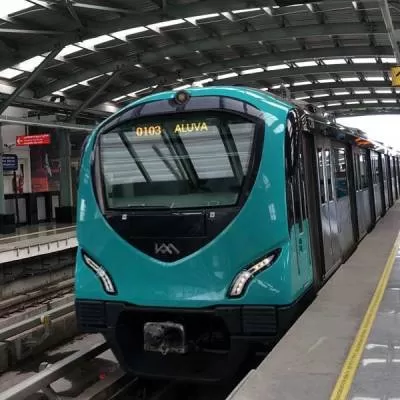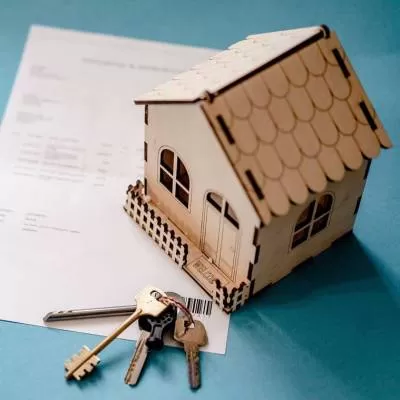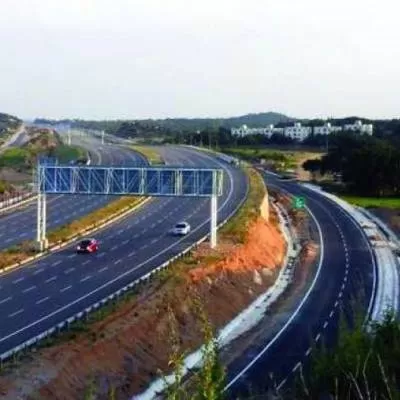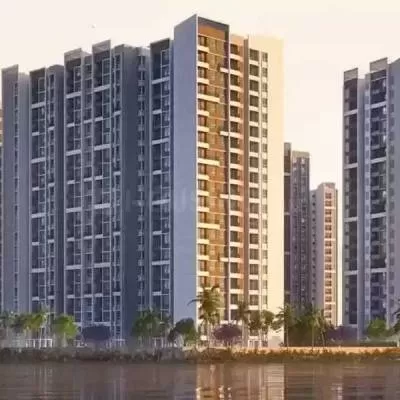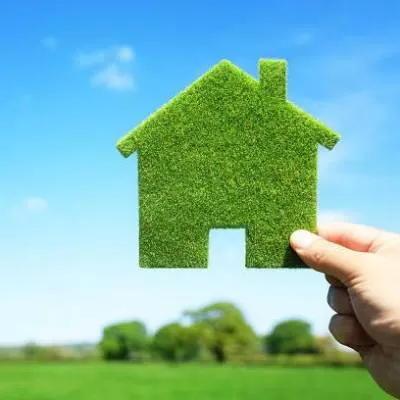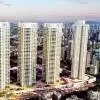- Home
- Real Estate
- Whilst possibilities of scams in the construction industry are high, we have tried to change this
Whilst possibilities of scams in the construction industry are high, we have tried to change this
Rahul Todi, Managing Director, Bengal Shrachi Housing Development Ltd
A classic case of public-private partnership, and successful at that!
When Kolkata-based Shrachi Group, and the Government of West Bengal, realised there was a critical need for mass affordable housing in the East, the two promptly joined hands to form Bengal Shrachi Housing Development Limited — a JV between the West Bengal Housing Board and Shrachi, intended to take housing and infrastructure to the next level.
Armed with the Shrachi legacy, and a young and dynamic leadership, Bengal Shrachi Housing Development Limited forged ahead, never looking back. In a time span of over 10 years, the company has spearheaded big-ticket development projects, the likes of Greenwood Park, Greenwood Park Extension, Greenwood Nook and Greenwood Sonata, to name a few. Rahul Todi, Managing Director, Bengal Shrachi Housing Development Limited, in conversation with CW…
When and why was Bengal Shrachi Housing Development Limited formed? What is the ratio of ownership between the West Bengal Housing Board and Shrachi Group in this JV?
Bengal Shrachi Housing Development Limited was incorporated on June 11, 1997. The main objectives of the company include acquiring lands and property through purchase, lease, exchange, hire or otherwise for constructing houses, buildings or works of every description; undertaking consultancy in real estate and construction and so on. The West Bengal Housing Board (WBHB) owns 49.97 per cent share while Shrachi Developers Pvt Ltd holds 49.60 per cent share in this JV.
As a public-private enterprise in the construction sector, how different is Bengal Shrachi Housing Development Limited from private builders? What are the advantages and disadvantages of being so?
Bengal Shrachi Housing Development Limited was formed as a JV (Joint Sector Company) by WBHB and Shrachi, for development, marketing, sale/lease, etc. Ownership of land remains in the name of WBHB, which provides a development agreement and a power of attorney to the JV. While the development agreement enables the JV to develop, construct on the land and market the constructed area, the power of attorney enables it to act on behalf of the government to get approval/ sanction, sign documents for transfer, etc. to end users.
As a public-private enterprise in the construction domain, Bengal Shrachi definitely enjoys certain advantages over private builders. While it is Shrachi that has to fulfill limitations of Government resources and meet the infrastructure gap, and fulfill the need for new financing and institutional mechanisms, areas such as land acquisition and environmental clearances are facilitated by the Government. The structure of governance is such that consumer and public interests are safeguarded. Collectively, this model ensures transparent and well-conceived contracts, with documentation recognising the rights and responsibilities of all parties involved. Moreover, it involves participation of a large number of institutions, the Government, banks, investors, contractors, NGOs and so on.
While construction is the second largest contributor to the country's GDP, it is associated more with scams, corruption, et al. What is your view? Do you have any plans to change this perception?
Yes, the possibility of scams, corruption, etc. in the construction industry is high. While we are aware of this, we have also taken some steps that have definitely helped in changing this perception. Firstly, activities of all departments have been brought under ERP systems to make them fully transparent. Secondly, utmost care is taken in the selection of staff in terms of honesty and integrity. Thirdly, we have introduced a system of internal audit, where quarterly audits are done via two reputed chartered accountant firms. Lastly, we have introduced standard operating procedures (SOP) across the organisation to further streamline and improve the systems that are already in place.
Can you please provide details of the projects completed by you?
In the residential space, we have completed the following projects:
Greenwood Park, constituting 30,470 sq m of developed area, houses 62 LIG, 128 MIG and 200 HIG apartments of different sizes, along with support services, institutional and recreational requirements, not to mention a convenient market complex. The project, costing Rs 336 mn, was completed on March 31, 2006.
Greenwood Nook, located on the western bank of Eastern Metropolitan By-Pass, was completed on November 8, 2007 at a total cost of Rs 389 mn. The HIG Block aka Coral Isle houses 190 flats, including 10 duplex apartments. The total area developed is 32,050 sq m.
Breaking the monotony of matchbox-type flats is Greenwood Park Extension, which stands out with its Emerald Isle Extension — a pair of cylindrical towers that are a sight to behold. There is also an MIG and LIG phase, with total built up area of 2.77 lakh sq ft. This project, constituting 25,730 sq m of developed area, was completed on March 31, 2008 at a total cost of Rs 283.40 mn
Greenwood Sonata, constituting 51,650 sq m of developed area, comprises 7 buildings with a total 498 residential apartments. There are different categories of housing units, in keeping with cross-subsidy norms laid down by the Government of West Bengal. Sonata wears a trendy, international look both from the inside as well as the outside, and houses HIG, MIG and LIG phases. The project, having a total built up area of 5.56 lakh sq ft, was completed on March 31, 2009 at a total cost of Rs 765.90 mn.
In the commercial/retail space, Bengal Shrachi has completed Block by Block, a complete home solutions mall housing over 150 shops spread across 2.50 lakh sq ft, displaying some of the country's finest home furnishings brands. The project, constituting 20,620 sq m of developed area, was completed on June 18, 2009 at a total cost of Rs 650 mn.
Any other projects you would like to talk about?
Bengal Shrachi's main focus has been the eastern region of India, particularly Tier II and III cities. Among the company's current projects is a 254 acre township in Burdwan called Renaissance, which is intended to decongest the town, and provide gated living with facilities such as a club being built by Sinclairs, health care, etc. Bengal Shrachi has tied-up with international schools and colleges for them to be part of this township to provide that real charm of finding just about everything round-the-corner. Recently, we have collaborated with Sporting Edge, which has Steve Waugh as one of its partners, to build an international sports city within Renaissance. The sports city will have a soccer and cricket academy to encourage children to participate in sports, and encourage their parents to spend quality time with them. Apart from bungalows and high rises, we have introduced the concept of second home and senior citizens' apartments in this township.
Yet another current project is a 12 acre project in Jamshedpur, which is mixed-use by nature, where we have introduced high rises along with town houses and bungalows. Among projects that are in the pipeline, we are about to launch one of the most prestigious projects in New Town, Action Area III, Kolkata, called Epicentre. Spread across nearly 21 acre, Epicentre will house high rises, hotels, commercial and retail space.
What is the role of technology in your projects? Have you deployed any new technologies recently?
Technology plays a major role in construction. At each step, definite technical inputs are required. Various innovations are now being used to replace old materials, which are either scarce, or so as to make way for better performance and greater longevity.
For instance, we use polymer-based pipes (PPR, CPVC, UPVC) for water distribution and drainage instead of GI and cast iron pipes that are prone to scales, rust, etc. Further, we use reinforced polymer concrete (PCPC) gratings, drain and manhole covers in place of cast iron or iron. We have also replaced wooden door frames with imported metal door frames in all of our recent projects.
In 2006, Bengal Shrachi entered into an agreement with Living Steel (a global programme managed by the International Iron and Steel Institute) to set up India's first prototype sustainable steel building at Rajarhat, Kolkata. Has there been any progress on this front?
Shrachi is known for its innovative approach to housing. Recently, we associated with one of UK's most promising architectural studios, Piercy Conner, to develop the first steel residential building in Kolkata named Restello.
Restello is luxury living, reinvented; a new experience altogether. Steel structures make for greater stability, longer life, creating uninterrupted living spaces. Restello is capable of resisting earthquakes, fires and high winds. The perforated steel façade allows fresh air to circulate without compromising on privacy or security. The façade also provides greater thermal comfort and reduces the need for air conditioning. Galvanised and painted steel protects against corrosion, dampness and termites. Overall, Restello is designed to enhance the quality of life.
However, the fact is that steel structures are not so popular in India as in the developed world for a variety of reasons. Steel is expensive and cannot be used in large-scale construction. Labour being cheap, dry construction is again not very popular. Also, we do not have large span structures other than industrial sheds, and we rarely construct buildings that are over 42-45 floors high. Most of all, it is difficult to find structural engineers who are conversant with steel structures. Besides, rules and regulations pertaining to construction pose a major constraint, and many provisions would have to be revised in order to actually accommodate steel structures in urban areas.
Do you think 'green' is an overrated concept? Can you give us examples of sustainable practices incorporated in your projects?
On the contrary, 'green' is a great concept. We have recently completed a green building in the commercial space called Synthesis Business Park, where we have adopted the following sustainability measures:
- The building is oriented in such a way that the sun's rays enter through the front façade glass.
- Double glazing with a 12 mm air gap, with green-tinted low 'e' glass has been provided in the façade for better thermal insulation.
- Properly oriented louvers have been provided to arrest direct heating of the glazing.
- HVAC has been designed so as to bring down the requirement for chillers by a few notches below normal.
- Recycled materials like cobble stone, glass, etc. have been used in large quantities.
How important are ethics in the business of construction?
Ethics are important in every business. We have built our brand over so many years only on the basis of trust, honesty and if you like, 'under promise, over deliver'. Ethics are an integral part of our business, and we strongly believe that our sound ethics help us provide better home solutions, for now and in the future.
Not only has West Bengal lost out on key projects due to restrictions on townership of land, even real estate developers cannot build large housing and commercial complexes, except in partnership with the state government, or with its express approval. As a public-private enterprise in construction, what are your views on this?
This isn't true. As a private partner, we have ventured into large projects, including South City, Urbana, etc. in Kolkata. Many big development projects in West Bengal are seen abiding by government rules and regulations. There is a huge demand for real estate in Tier II and III cities in West Bengal, and the state is witnessing rapid growth. Indeed, Kolkata will be able to establish itself as a world class city in the near future.
Fact Sheet:
Year of Establishment: June 11, 1997
Top Management (promoters) Chairman: Gopal Mukherjee Managing, Director: Rahul Todi, Directors: Shrawan Kumar Todi, Ravi Todi, Sandeep Agarwal, Gour Hari Majee, Dilip Kumar Dutta, Sanjeev Agarwal, Sudhansu Sekhar Naskar
No. of employees: 175
Centres of operation: Kolkata
Turnover: Rs 22.35 crore in FY 2009-2010
Ongoing Projects: Synthesis Business Park, Greenwood Elements, Restello, Greenwood Nest, Dakshinatto
Upcoming Projects: Epicentre
Give us your feedback on this interview at feedback@ASAPPmedia.com
- Construction
- Update
- Portal
- Magazine
- CW-India
- May
- 2011
- India
- Rahul Todi
- Bengal Shrachi Housing Development Ltd
- Kolkata
- Shrachi Group
- West Bengal
- West Bengal Housing Board
- housing
- infrastructure
- Greenwood Park
- Government
- environmental clearances
- ERP systems
- SOP
- Emerald Isle Extension
- home furnishings
- Burdwan
- Renaissance
- Sinclairs
- Sporting Edge
- Jamshedpur
- Steve Waugh
- Epicentre
- PCPC
- Piercy Conner
- Restello
- Synthesis Business Park
Rahul Todi, Managing Director, Bengal Shrachi Housing Development Ltd A classic case of public-private partnership, and successful at that! When Kolkata-based Shrachi Group, and the Government of West Bengal, realised there was a critical need for mass affordable housing in the East, the two promptly joined hands to form Bengal Shrachi Housing Development Limited — a JV between the West Bengal Housing Board and Shrachi, intended to take housing and infrastructure to the next level. Armed with the Shrachi legacy, and a young and dynamic leadership, Bengal Shrachi Housing Development Limited forged ahead, never looking back. In a time span of over 10 years, the company has spearheaded big-ticket development projects, the likes of Greenwood Park, Greenwood Park Extension, Greenwood Nook and Greenwood Sonata, to name a few. Rahul Todi, Managing Director, Bengal Shrachi Housing Development Limited, in conversation with CW… When and why was Bengal Shrachi Housing Development Limited formed? What is the ratio of ownership between the West Bengal Housing Board and Shrachi Group in this JV?Bengal Shrachi Housing Development Limited was incorporated on June 11, 1997. The main objectives of the company include acquiring lands and property through purchase, lease, exchange, hire or otherwise for constructing houses, buildings or works of every description; undertaking consultancy in real estate and construction and so on. The West Bengal Housing Board (WBHB) owns 49.97 per cent share while Shrachi Developers Pvt Ltd holds 49.60 per cent share in this JV. As a public-private enterprise in the construction sector, how different is Bengal Shrachi Housing Development Limited from private builders? What are the advantages and disadvantages of being so? Bengal Shrachi Housing Development Limited was formed as a JV (Joint Sector Company) by WBHB and Shrachi, for development, marketing, sale/lease, etc. Ownership of land remains in the name of WBHB, which provides a development agreement and a power of attorney to the JV. While the development agreement enables the JV to develop, construct on the land and market the constructed area, the power of attorney enables it to act on behalf of the government to get approval/ sanction, sign documents for transfer, etc. to end users. As a public-private enterprise in the construction domain, Bengal Shrachi definitely enjoys certain advantages over private builders. While it is Shrachi that has to fulfill limitations of Government resources and meet the infrastructure gap, and fulfill the need for new financing and institutional mechanisms, areas such as land acquisition and environmental clearances are facilitated by the Government. The structure of governance is such that consumer and public interests are safeguarded. Collectively, this model ensures transparent and well-conceived contracts, with documentation recognising the rights and responsibilities of all parties involved. Moreover, it involves participation of a large number of institutions, the Government, banks, investors, contractors, NGOs and so on. While construction is the second largest contributor to the country's GDP, it is associated more with scams, corruption, et al. What is your view? Do you have any plans to change this perception?Yes, the possibility of scams, corruption, etc. in the construction industry is high. While we are aware of this, we have also taken some steps that have definitely helped in changing this perception. Firstly, activities of all departments have been brought under ERP systems to make them fully transparent. Secondly, utmost care is taken in the selection of staff in terms of honesty and integrity. Thirdly, we have introduced a system of internal audit, where quarterly audits are done via two reputed chartered accountant firms. Lastly, we have introduced standard operating procedures (SOP) across the organisation to further streamline and improve the systems that are already in place. Can you please provide details of the projects completed by you?In the residential space, we have completed the following projects: Greenwood Park, constituting 30,470 sq m of developed area, houses 62 LIG, 128 MIG and 200 HIG apartments of different sizes, along with support services, institutional and recreational requirements, not to mention a convenient market complex. The project, costing Rs 336 mn, was completed on March 31, 2006. Greenwood Nook, located on the western bank of Eastern Metropolitan By-Pass, was completed on November 8, 2007 at a total cost of Rs 389 mn. The HIG Block aka Coral Isle houses 190 flats, including 10 duplex apartments. The total area developed is 32,050 sq m. Breaking the monotony of matchbox-type flats is Greenwood Park Extension, which stands out with its Emerald Isle Extension — a pair of cylindrical towers that are a sight to behold. There is also an MIG and LIG phase, with total built up area of 2.77 lakh sq ft. This project, constituting 25,730 sq m of developed area, was completed on March 31, 2008 at a total cost of Rs 283.40 mn Greenwood Sonata, constituting 51,650 sq m of developed area, comprises 7 buildings with a total 498 residential apartments. There are different categories of housing units, in keeping with cross-subsidy norms laid down by the Government of West Bengal. Sonata wears a trendy, international look both from the inside as well as the outside, and houses HIG, MIG and LIG phases. The project, having a total built up area of 5.56 lakh sq ft, was completed on March 31, 2009 at a total cost of Rs 765.90 mn. In the commercial/retail space, Bengal Shrachi has completed Block by Block, a complete home solutions mall housing over 150 shops spread across 2.50 lakh sq ft, displaying some of the country's finest home furnishings brands. The project, constituting 20,620 sq m of developed area, was completed on June 18, 2009 at a total cost of Rs 650 mn. Any other projects you would like to talk about? Bengal Shrachi's main focus has been the eastern region of India, particularly Tier II and III cities. Among the company's current projects is a 254 acre township in Burdwan called Renaissance, which is intended to decongest the town, and provide gated living with facilities such as a club being built by Sinclairs, health care, etc. Bengal Shrachi has tied-up with international schools and colleges for them to be part of this township to provide that real charm of finding just about everything round-the-corner. Recently, we have collaborated with Sporting Edge, which has Steve Waugh as one of its partners, to build an international sports city within Renaissance. The sports city will have a soccer and cricket academy to encourage children to participate in sports, and encourage their parents to spend quality time with them. Apart from bungalows and high rises, we have introduced the concept of second home and senior citizens' apartments in this township. Yet another current project is a 12 acre project in Jamshedpur, which is mixed-use by nature, where we have introduced high rises along with town houses and bungalows. Among projects that are in the pipeline, we are about to launch one of the most prestigious projects in New Town, Action Area III, Kolkata, called Epicentre. Spread across nearly 21 acre, Epicentre will house high rises, hotels, commercial and retail space. What is the role of technology in your projects? Have you deployed any new technologies recently?Technology plays a major role in construction. At each step, definite technical inputs are required. Various innovations are now being used to replace old materials, which are either scarce, or so as to make way for better performance and greater longevity. For instance, we use polymer-based pipes (PPR, CPVC, UPVC) for water distribution and drainage instead of GI and cast iron pipes that are prone to scales, rust, etc. Further, we use reinforced polymer concrete (PCPC) gratings, drain and manhole covers in place of cast iron or iron. We have also replaced wooden door frames with imported metal door frames in all of our recent projects. In 2006, Bengal Shrachi entered into an agreement with Living Steel (a global programme managed by the International Iron and Steel Institute) to set up India's first prototype sustainable steel building at Rajarhat, Kolkata. Has there been any progress on this front?Shrachi is known for its innovative approach to housing. Recently, we associated with one of UK's most promising architectural studios, Piercy Conner, to develop the first steel residential building in Kolkata named Restello. Restello is luxury living, reinvented; a new experience altogether. Steel structures make for greater stability, longer life, creating uninterrupted living spaces. Restello is capable of resisting earthquakes, fires and high winds. The perforated steel façade allows fresh air to circulate without compromising on privacy or security. The façade also provides greater thermal comfort and reduces the need for air conditioning. Galvanised and painted steel protects against corrosion, dampness and termites. Overall, Restello is designed to enhance the quality of life. However, the fact is that steel structures are not so popular in India as in the developed world for a variety of reasons. Steel is expensive and cannot be used in large-scale construction. Labour being cheap, dry construction is again not very popular. Also, we do not have large span structures other than industrial sheds, and we rarely construct buildings that are over 42-45 floors high. Most of all, it is difficult to find structural engineers who are conversant with steel structures. Besides, rules and regulations pertaining to construction pose a major constraint, and many provisions would have to be revised in order to actually accommodate steel structures in urban areas. Do you think 'green' is an overrated concept? Can you give us examples of sustainable practices incorporated in your projects?On the contrary, 'green' is a great concept. We have recently completed a green building in the commercial space called Synthesis Business Park, where we have adopted the following sustainability measures: The building is oriented in such a way that the sun's rays enter through the front façade glass. Double glazing with a 12 mm air gap, with green-tinted low 'e' glass has been provided in the façade for better thermal insulation. Properly oriented louvers have been provided to arrest direct heating of the glazing. HVAC has been designed so as to bring down the requirement for chillers by a few notches below normal. Recycled materials like cobble stone, glass, etc. have been used in large quantities. How important are ethics in the business of construction?Ethics are important in every business. We have built our brand over so many years only on the basis of trust, honesty and if you like, 'under promise, over deliver'. Ethics are an integral part of our business, and we strongly believe that our sound ethics help us provide better home solutions, for now and in the future. Not only has West Bengal lost out on key projects due to restrictions on townership of land, even real estate developers cannot build large housing and commercial complexes, except in partnership with the state government, or with its express approval. As a public-private enterprise in construction, what are your views on this?This isn't true. As a private partner, we have ventured into large projects, including South City, Urbana, etc. in Kolkata. Many big development projects in West Bengal are seen abiding by government rules and regulations. There is a huge demand for real estate in Tier II and III cities in West Bengal, and the state is witnessing rapid growth. Indeed, Kolkata will be able to establish itself as a world class city in the near future. Fact Sheet: Year of Establishment: June 11, 1997Top Management (promoters) Chairman: Gopal Mukherjee Managing, Director: Rahul Todi, Directors: Shrawan Kumar Todi, Ravi Todi, Sandeep Agarwal, Gour Hari Majee, Dilip Kumar Dutta, Sanjeev Agarwal, Sudhansu Sekhar NaskarNo. of employees: 175Centres of operation: KolkataTurnover: Rs 22.35 crore in FY 2009-2010 Ongoing Projects: Synthesis Business Park, Greenwood Elements, Restello, Greenwood Nest, DakshinattoUpcoming Projects: Epicentre Give us your feedback on this interview at feedback@ASAPPmedia.com


